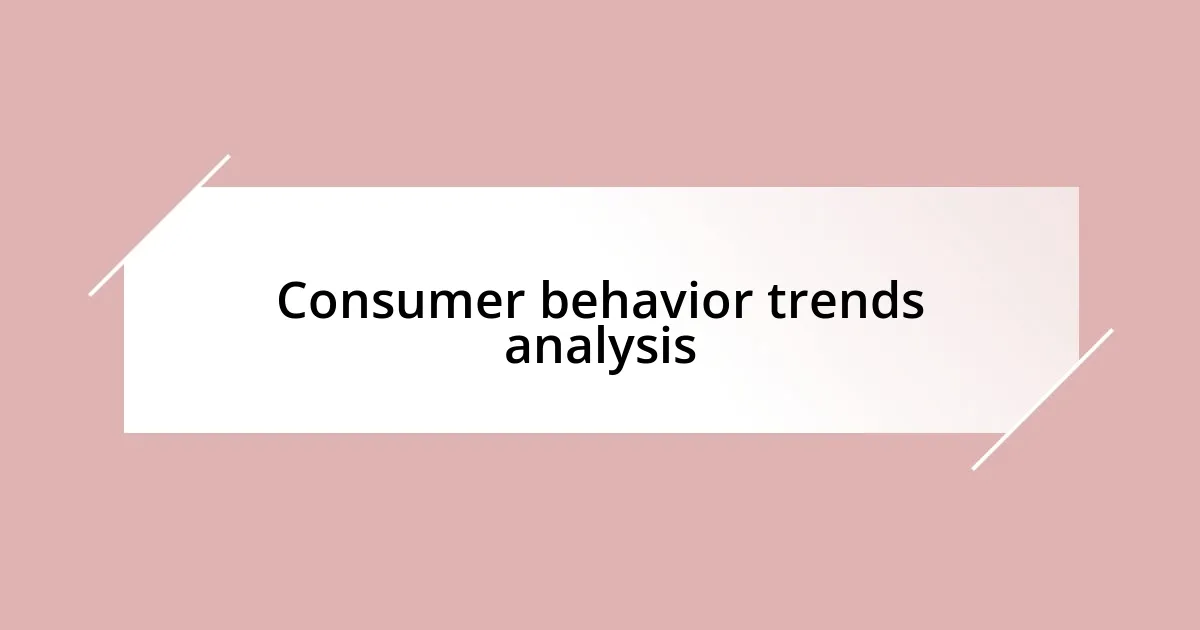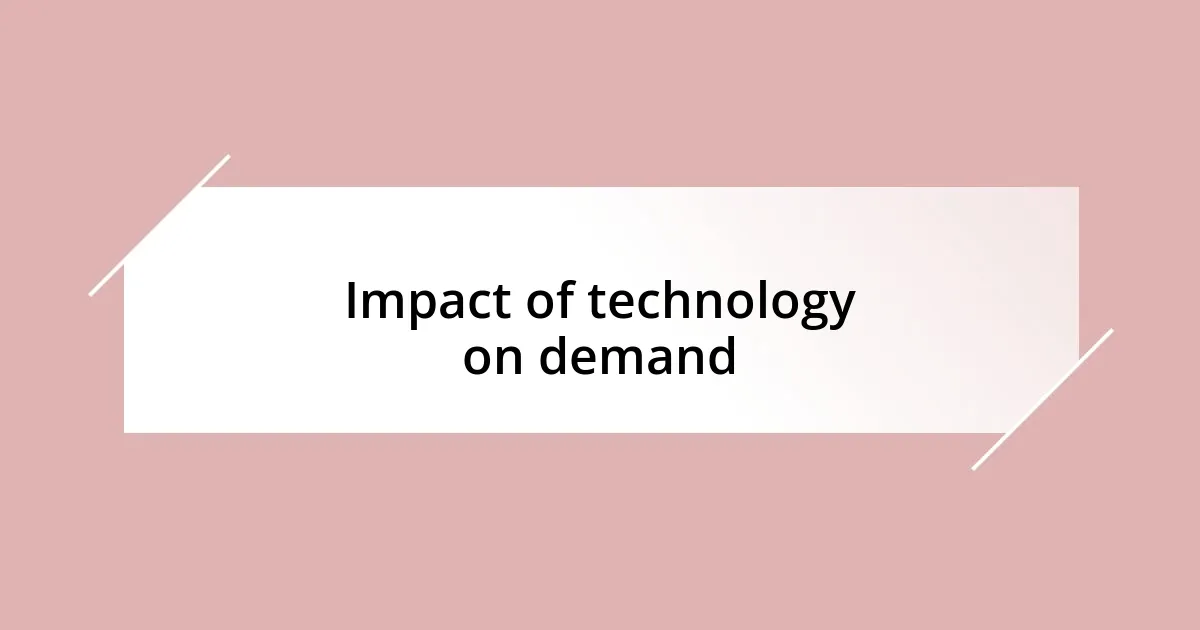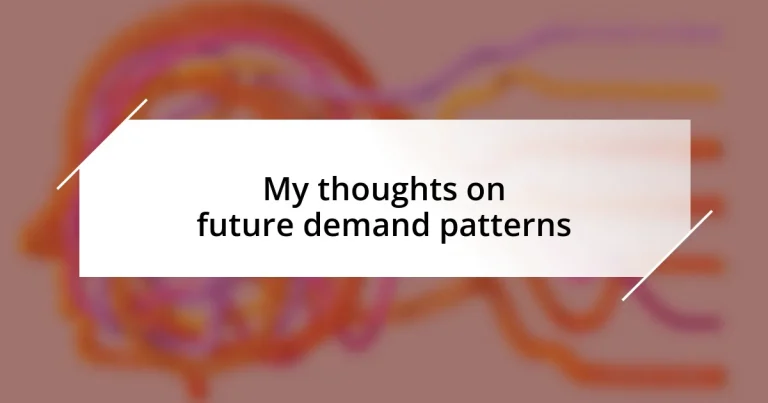Key takeaways:
- Demand is shifting towards sustainable products as consumers prioritize environmental concerns and authenticity.
- The rise of e-commerce and technology has transformed purchasing behaviors, emphasizing the need for personalized and engaging brand experiences.
- Younger generations value unique experiences over material goods, influencing brands to focus on authentic engagement.
- Effective demand prediction relies on data analytics, consumer sentiment analysis, and direct customer engagement to better understand market trends.

Future demand patterns overview
As I’ve delved into the future demand patterns, I can’t help but feel a mix of excitement and intrigue. The shift toward sustainability is becoming a dominant theme, and I often wonder how businesses can adapt to this new landscape. Remember the increasing number of consumers purchasing eco-friendly products? It’s a clear signal that demand will undoubtedly gravitate towards offerings that prioritize environmental concerns.
In my observation, the rise of technology and digital interactions is fundamental. Have you noticed how people are increasingly shopping online? This shift has altered not just consumer behavior, but also how products are marketed. Companies must embrace data analytics and artificial intelligence to understand these evolving preferences. I recall a time when I hesitated to buy groceries online, but now it feels like second nature. This personal transition illustrates a broader societal change that businesses can’t afford to overlook.
Looking ahead, I find it fascinating to think about the demographic changes on demand patterns. With younger generations entering the consumer market, their unique values and preferences are essential to consider. Reflecting on my discussions with friends, it’s clear that experiences often trump material goods for this group. How will this influence brands trying to capture their attention? The demand for authentic engagement and meaningful experiences is palpable, and I believe it will define the future market landscape.

Key factors influencing demand
As I reflect on the key factors influencing demand, I recognize that consumer behavior is significantly shaped by cultural shifts and values. For instance, I remember how my own perspective on convenience has shifted as life gets busier; I now favor brands that offer streamlined online experiences. This aligns with the trend where consumers prioritize brands that blend accessibility with sustainability.
Here are some essential factors that impact demand:
– Cultural trends: Shifts in societal values can redefine what consumers want and need.
– Economic conditions: Changes in income levels and employment rates can directly affect purchasing power.
– Technological advancements: Innovations can create new needs or alter existing ones, as we’ve seen with the rise of smart home devices.
– Demographics: Different age groups bring varying preferences; for instance, younger consumers often seek authenticity and purpose.
– Seasonality: Certain products have demand spikes during specific times, like holiday shopping or summer gear.
Connecting these dots helps me understand just how intricate and intertwined these factors are. The emotional connection consumers have with products can also dictate demand. I once found myself drawn to a brand simply because their story resonated with my values. That illustrates the power of narrative in influencing consumer choices.

Consumer behavior trends analysis
Understanding consumer behavior trends allows us to anticipate demand patterns effectively. It’s intriguing to see how environmental consciousness is reshaping purchasing decisions. I remember standing in a grocery aisle, carefully weighing the impact of my choices—should I go for that plastic-wrapped product or the one in eco-friendly packaging? This personal dilemma reflects a broader shift, as consumers today often lean towards brands that prioritize sustainability.
Additionally, I’ve observed that social media has drastically transformed how brands interact with consumers. Having spent hours scrolling through Instagram, it’s clear that visual storytelling captivates audiences. I often find myself engaging with brands that resonate well with my lifestyle through aesthetically pleasing feeds. This trend indicates that businesses must curate not just products but experiences that align with consumer values to foster loyalty.
Looking meticulously at demographic influences, I find younger consumers’ preferences quite fascinating. They seem to value unique and memorable experiences over the typical purchasing mindset. A friend once told me how she chose to attend a local art event instead of buying a new piece of clothing. This behavior speaks volumes about a generation that seeks authentic connections and experiences—a factor brands must prioritize if they wish to stay relevant.
| Trend | Impact on Demand |
|---|---|
| Sustainability | Increased purchases of eco-friendly products |
| Social Media Engagement | Higher brand loyalty through visual storytelling |
| Experience over Material Goods | Demand for unique, memorable experiences |

Impact of technology on demand
Technology has significantly reshaped consumer demand, creating new avenues for purchasing that were unimaginable just a few years ago. I often find myself scrolling through a shopping app with personalized recommendations based on my previous purchases. This not only influences what I decide to buy but also introduces me to products I didn’t even know I needed. Isn’t it fascinating how algorithms can anticipate our desires?
The rise of e-commerce has fostered a sense of immediacy in buying behavior. I recall an instance where, after watching an engaging online ad, I made an impulse purchase for a gadget that seemed essential for my daily routine. This highlights how technology shortens the consumer’s journey from awareness to purchase decision, making it easier than ever to fulfill latent desires almost instantly.
Furthermore, the integration of advanced technologies like artificial intelligence and augmented reality is revolutionizing how we engage with products. I remember trying on virtual clothing through an app—it changed the way I approach fitting rooms entirely. How can brands leverage such technologies to enhance customer experience? It’s this curiosity that drives companies to explore innovative solutions, ultimately shaping demand for experiences rather than just products.

Sustainability and demand shifts
Sustainability is rapidly becoming a driving force in purchasing decisions, with consumers increasingly mindful of their environmental footprint. During my last shopping trip, I found myself gravitating towards a brand that not only emphasized eco-friendly materials but also shared the story behind their sustainable practices. It made me wonder—how many consumers are genuinely aware of the impact their choices can make? The more we delve into this notion, the clearer it becomes that sustainability is not just a trend; it’s a necessity that shapes demand patterns.
In conversations with friends, I often hear about how they’ll pay a premium for products that align with their values. Just the other day, a colleague mentioned how she actively seeks out companies that are transparent about their supply chain and sustainability efforts. This passion reflects a broader sentiment; consumers are willing to engage with brands that prioritize the planet over profit. It’s a powerful shift that challenges businesses to re-evaluate their strategies and genuinely incorporate sustainable practices into their operations.
Looking at the future, I can’t help but feel that the demand for sustainability will only intensify. What excites me about this shift is the emergence of innovative solutions that brands are exploring, such as items made from recycled materials or practices that minimize waste. Recently, I stumbled upon a local startup that transforms discarded fabrics into stylish handbags. It made me think—how can we encourage more companies to follow suit? This drive for sustainability not only changes consumer preferences but also invites creativity and collaboration across industries, ultimately redefining what it means to be a responsible brand in today’s world.

Strategies for predicting demand
To effectively predict demand, leveraging data analytics is crucial. I remember attending a workshop where we analyzed historical sales data, uncovering patterns that I could hardly believe were hidden in plain sight. It struck me how important it is to collect and interpret vast amounts of data—what if the next big trend is simply waiting for someone to reveal it? The insights from these analyses can guide inventory management and marketing strategies, making businesses more agile.
Another strategy worth considering is consumer sentiment analysis. I often check social media trends to gauge what people are talking about, as emotions driven by current events can heavily influence demand. For example, during an event like Earth Day, I’ve noticed a surge in interest for sustainable products, all driven by collective consciousness. Harnessing these sentiments allows businesses to align their offerings with what consumers are actively seeking, helping them predict demand with greater accuracy.
Engaging directly with customers can be another invaluable approach. In my experience, sending out quick surveys or having casual chats with friends has provided me with insights that data can’t always capture. Recently, I asked a group what factors influence their buying decisions, and the responses were eye-opening. When brands actively seek out this feedback, they create a dialogue that not only informs their demand predictions but also builds stronger relationships with consumers. Isn’t it fascinating how a simple conversation can pave the way for deeper understanding?

Adapting to changing demand patterns
Adapting to changing demand patterns requires businesses to be more than just reactive; they need to be proactive. I recall when a friend of mine launched her own sustainable fashion line. She didn’t just follow trends; she anticipated them by engaging with her audience through social media. This connection drove her to design pieces that resonated on a personal level, proving that understanding consumer desires can lead to meaningful innovations.
Flexibility is key in adjusting to these fluctuating demands. I once attended a seminar where a speaker shared how a major retailer rapidly shifted its supply chain after noticing a spike in demand for eco-friendly products. It reminded me of the power of being able to pivot quickly. When companies are willing to adapt their offerings in real-time, they not only meet consumer expectations but also build a loyal customer base that appreciates their responsiveness.
Integrating sustainability into core business strategies is not just a trend; it’s a roadmap for future growth. I often think back to a time when a friend was hesitant to buy a luxury item primarily due to his concerns about its environmental impact. His change in purchasing behavior illustrates a broader movement towards conscientious spending. How many others are grappling with similar thoughts? By understanding this, companies can align their missions with consumer values, ensuring that they are not just part of the conversation, but leading it.














